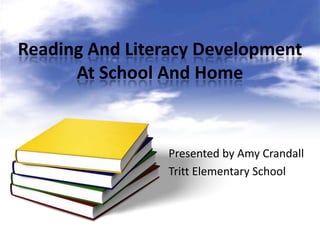
Reading and literacy development
- 1. Reading And Literacy Development At School And Home Presented by Amy Crandall Tritt Elementary School
- 2. Table Talk • What is one of your earliest memories with reading? • What was your favorite book as a child? • Does your child see you read much now?
- 3. When does reading instruction begin? • Emergent comprehension considers children’s early experiences as foundations upon which to support later text comprehension. Dooley and Matthews (2009) • Your child has been developing reading skills for the last 5-6 years.
- 4. Did you know? • Children who are read to – do better in school – have more self-esteem and confidence – will independently read a book that is read to them Evans (1999)
- 5. The Five Dimensions of Reading “When children become good readers in the early grades, they are more likely to become better learners throughout their school years and beyond.” National Reading Panel (2000) • Phonemic Awareness • Phonics • Fluency • Vocabulary • Comprehension
- 6. Phonemic Awareness • Recognize words that begin with the same sound – Ball, big, boat • Isolate the first or last sound in a word – /g/ for dig • Blend the separate sounds in a word to say the word – "/m/, /a/, /p/-- map." • Segment a word into its separate sounds – "up--/u/, /p/"
- 7. Phonemic Awareness School - Home Connection At School: At Home: • Provide opportunities for • Read daily to your child children to practice with • Visit the library the sounds that make up • Play alphabet games words . • Play rhyming games • help children learn to • Model reading recognize letter names and shapes. •Read to students every day. Family involvement theory and children’s academic achievement (Galindo and Sheldon, 2012)
- 8. Phonics • Recognize word patterns in order to decode words easily. For example, – silent e, (bake, kite) – Diagraphs th, sh,ch (chin, bath)
- 9. Phonics School – Home Connection At School: At Home: •Teach how sounds and •Read daily to your child letters are related •Go on a “word hunt” before •Provide opportunities to reading a book. practice the letter-sound •Visit the library relationships they are •Allow your child to practice learning reading to you •Model Reading
- 10. Fluency • The ability to read text accurately and quickly. • Readers can now focus on the meaning of text. • Sight Word Mastery
- 11. Fluency School – Home Connection At School: At Home: • Practice reading sight •Listen as your child reads aloud words in learning centers •Review sight words •Provide opportunities to •Choral read stories reread stories to self and •Practice reading familiar books others. with expression •Go on a “word hunt” before reading a book
- 12. Vocabulary • Words we must know to communicate effectively. • Two Types of Vocabulary: – Oral Vocabulary – Reading Vocabulary
- 13. Vocabulary School – Home Connection At School: At Home: •Provide opportunities to •Read predictive and wordless use new words orally and books to your child during reading. •Talk often with your child •Teach the meaning of the new words.
- 14. Comprehension First we learn to read and then we read to learn Jeanne Chall (1983) • Process of understanding or making meaning when reading • Students should: – be aware of what they understand, – identify what they do not understand, and – use strategies to resolve problems in comprehension.
- 15. Comprehension School – Home Connection At School: At Home: •Preview a book •Read predictive and wordless •Make connections to story books with self, other text •Practice reading familiar •Answer Who? What? books for expression Where? When? Why? •Before reading: Go on a •Demonstrate what good “picture walk” readers look •After reading: ask questions •Play “Stump Me.”
- 16. The Bottom Line…. “Nothing is greater to a child, than a teacher and the parent coming together for their sake.” Sokolinski (2012)
- 17. References Armbruster, Bonnie; Lehr, Fran, & Osborn, Jean. (2006). A child becomes a reader: Kindergarten through grade 3. Proven ideas from research for parents. Third Edition. National Institute for Literacy. Retrieved from ERIC (ED512442). Dooley, C. & Matthews, M. (2009). Emergent Comprehension: Understanding Comprehension Development Among Young Literacy Learners. Journal of Early Childhood Literacy, 9, 269-294. Elish-Piper, Laurie (2010). Understanding reading comprehension: Information and ideas for parents about reading comprehension. Illinois Reading Council Journal, 38 (3), 48-52. Elish-Piper, Laurie, Almburg, Anne, Di Domenico, Paula, Henry, Michael, Morley, Samantha, & Sokolinski, Susan. (2012). Parent involvement in reading. Illinois Reading Council Journal, 40 (3). 55-60. Evans, Sue. (1999). Parent power: Helping your child become a better reader. Retrieved from ERIC. (ED426354). Galindoa, Claudia & Sheldon, Steven. (2012). School and home connections and children’s kindergarten achievement gains: The mediating role of family involvement. Early Childhood Research Quarterly, 27, 190-103. Granfield, Michelle & Smith, Christy. (1995). Teaching parents reading strategies: Changing parents attitudes towards reading at home. Retrieved from ERIC. (ED382940). National Institute for Reading. (). Putting reading first: Helping your child learn to read. Jessup, MD: Partnership for Reading. National Institute of Child Health and Human Development (2001). Put reading first: The research building blocks for teaching children to read. Retrieved on July 9, 2012: http://www.nichd.nih.gov/publications/pubs/PRF-teachers-k-3.cfm#phonemic National Reading Panel. (2000). Teaching children to read. Report by the National Reading Panel.
Hinweis der Redaktion
- ("Bell, bike, and boy all have /b/ at the beginning.");("The beginning sound of dog is /d/." "The ending sound of sit is /t/.");
- At SchoolAt Home:(begin with picture books. Consider child’s attention span and interests. Repetitive books Books with rhyming words)(make reading and interacting with books a positive experience not a chore)Letter Games with magnetic letters
- (invented spelling)